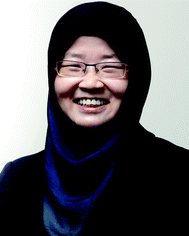Leveraging on being small—Singapore's strategy to catalyze integrative innovations
Yi-Chin
Toh
a,
Tae Goo
Kang
b,
Danny
van Noort
c,
Bill
Burkholder
d and
Jing Bo
Zhang
e
aInstitute of Bioengineering and Nanotechnology (IBN), A*STAR, 31 Biopolis Way, #04–01 Nanos, Singapore
bInstitute of Microelectronics (IME), A*STAR, 11 Science Park Road, Singapore Science Park II, Singapore
cMechanobiology Institute (MBI), National University of Singapore, T-Lab, #05–01, 5A Engineering Drive 1, Singapore
dInstitute of Materials Research and Engineering, A*STAR, 3 Research Link, Singapore
eData Storage Institute (DSI), A*STAR, DSI Building, 5 Engineering Drive 1, Singapore
Institute of Microelectronics (IME)
Tae Goo Kang
IME sets out to combat the universal healthcare issue by developing core technologies that leverage on IME's CMOS platform and strengths in silicon nanowire technology, circuit design, through silicon via (TSVs) and micro-electromechanical systems (MEMS) expertise. IME's BioElectronics (BE) program has spawned many individual micromodules that form the backbone of all-in-one devices for molecular and cell-based diagnostics that aim to reduce the reliance on labor-intensive and time-consuming batch-based laboratory tests. Based on IME's integrated sample-to-answer approach, they have demonstrated rapid point-of-care (POC) applications that utilize just a few drops of blood. IME's specially treated silicon nanowires can work as sensitive label-free biosensors to detect protein cardiac biomarkers or dengue virus. Using an innovative microfluidics system and a unique microchip design, IME has also devised a fast and sensitive bedside tool to measure rare circulating stem cells in blood for assessing suitable treatment options for heart patients. The design of medical devices that encompass improved precision, ultra-low power, minimal invasiveness and low cost drives the capabilities of IME's Miniaturized Medical Devices (MMD) program. IME's silicon nanowires can also be applied as highly sensitive miniature tactile sensors used in guidewire navigation for minimally-invasive surgical procedures.
Executive Director of IME
Institute of Bioengineering and Nanotechnology (IBN)
Yi-Chin Toh
The Institute of Bioengineering and Nanotechnology (IBN) was established in 2003 and is spearheaded by its Executive Director, Professor Jackie Yi-Ru Ying. Under her direction, IBN has established an effective model for interdisciplinary research bridging science, engineering and medicine. IBN's strengths lie in its synthetic capability for chemicals, materials and biologics. The Institute has developed unique technology platforms that combine novel catalytic chemistry, biomaterials, nanofabricated devices and microfluidic systems with biological engineering. Its highly collaborative environment also promotes the sharing of ideas, expertise and infrastructural support, and a culture that encourages innovative research and the nurturing of young talents.IBN aims to conduct strategic research that addresses important biomedical problems. This includes: fast and comprehensive molecular diagnosis for infectious diseases; green and efficient synthesis of safe and affordable pharmaceuticals; drug screening for cancer, fibrosis, brain and aging-related diseases; development of in vitro assays for complementing and replacing animal studies; safer and more effective delivery vehicles for small molecule drugs, proteins, genes and cells; and bioartificial organ assist devices and regenerative therapies.
Executive Director of IBN
Mechanobiology Institute (MBI)
Danny van Noort
The goal at the Mechanobiology Institute, Singapore (MBI), headed by Michael Sheetz, is to develop a new paradigm of biomedical research by focusing on the quantitative and systematic understanding of dynamic functional processes. MBI wants to understand the processes at both a biophysical and biochemical level through decomposition of the biomechanical processes into smaller functional steps.With the establishment of core facilities in micro/nanotechnology, microscopy and molecular biology, and an interdisciplinary team consisting of Singaporean and international researchers in medicine, biology, chemistry, physics, engineering and computing, MBI is poised to solve problems of cellular mechanics that underlie normal development and maladies from cancer and cardiovascular disease to aging. From bacteria to humans, mechanics is critical to the understanding of cell and tissue functions. The mechanics controls how cells are shaped, how they move, how they grow and how they form tissues.
One way to study mechanical influence on and by cells is to micro- and nanofabricate the environment around the cells. For example, micropillars can be used to measure forces within cells, while patterned surfaces affect the differentiation of stem cells.
Director of MBI
Microfluidics Systems Biology Lab
Bill Burkholder
The Microfluidics Systems Biology lab was established to address challenging questions related to cancer and developmental biology, microbial pathogenesis, and other areas of cell and molecular biology using cutting-edge microfluidic devices developed and prototyped in the lab of Prof. Stephen Quake at Stanford University. The lab is focused on several applications, which include: 1) genotyping single cells isolated from genetically heterogeneous populations such as tumors and microbial consortia, 2) characterizing gene regulation from small subpopulations of cells using chip-based chromatin-IP; and, 3) mapping regulatory networks and macromolecular assemblies using high-throughput measurements of protein–protein and protein–DNA binding affinities. Most projects will be pursued in close collaboration with research groups from government, academic, and industry labs. To promote interactions with colleagues related both to device engineering and to the primary focus of the lab on biological applications, the lab is affiliated with the Institute of Materials Research and Engineering (IMRE) and located at the Institute of Molecular and Cell Biology (IMCB), both part of the Singapore Agency for Science, Technology and Research (A*STAR).With all the information we are creating a manual for cellular and molecular function, describing step-by-step, modular understanding of cell mechanics across molecular, cellular and tissue levels.
p53 Lab
Sir David Lane
The p53 Lab is a new research lab under the BioMedical Research Council (BMRC), which focuses on the development of new therapies, new diagnostics and new discoveries in the p53 pathway. 11 million people living with cancer have specific mutations in the p53 gene leading to the production of a faulty p53 protein. This is half the cases of human cancer. In those that have an apparently normal p53 gene we believe that there are faults in the p53 pathway. We are using a variety of approaches to translate this extraordinary finding into clinical benefit. We work closely with many other groups both in Singapore and across the rest of the world to achieve this. We are using biochemical, biophysical, cell biological and genetic approaches in our work and offer an outstanding international training environment. Most recently working with SERC colleagues through the Joint Council Grant scheme, we have been developing ultra sensitive tests for cancer antigens in human serum by combining unique antibodies and novel biophysical approaches. We welcome scientists and engineers to bring new technologies in Lab-On-Chip to collaborate with our fundamental and clinical research, diagnosis and treatment to benefit cancer patients.
Chief Scientist of Agency for Science, Technology and Research (A*STAR)
Executive director, P53 Laboratory
As Singapore's scientists are increasingly adopting inter-disciplinary approaches to tackle problems, we are also becoming more experienced with the challenges of marrying two or more research disciplines. Besides identifying appropriate issues where technological input is going to make a difference to the issues faced by biomedical researchers or clinicians today, another critical factor to ensure that such integrative endeavours are successful is for the technologist and biologist/clinician to share the same vision and interact iteratively regarding the development of a device. According to Dr Mo Huang Li and Dr Emril Mohamed Ali at IBN who developed an integrated microsystem to expedite the diagnosis of infectious diseases:“The development of innovative medical devices for clinical applications, such as diagnostics and drug screening or monitoring, requires significant validation and head-to-head comparison with existing clinical protocols. Only with sufficient data to support the reliability and applicability of such novel devices, would the medical community accept the bio-applications. Hence, the key challenge for scientists and engineers in this field is to work and form strong partnerships with the appropriate clinical collaborators.”
Singapore's small geographical size probably bodes well for such interdisciplinary research in the same way that the small scale of microsystems enhances reaction efficiencies—the close proximity of the major research centers ensures ideas from various research disciplines are easily communicated and assimilated into new research approaches and innovations.
| This journal is © The Royal Society of Chemistry 2011 |





